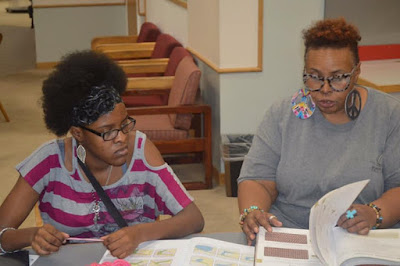Make It Your Own
by Gelenda Norman, Arts, Literature and Sports Department, Central Library
I have always had a thing for finding pieces that are unique and different. More intriguing is when the item is handmade. One day while browsing in one of my favorite boutiques, I happened upon a beautiful leather belt. Well, when I looked at the tag, it was $300. Yes, $300 for a piece of leather with a couple of punched holes with leather strings. The typical response: “I can make that myself!” Sooooo I left the shop and headed to a nearby craft shop and purchased a bag of leather remnants. With a nail and hammer, I created my own “$300 boutique belt.” Now don’t get me wrong, I respect the creativity and the workmanship of the designer of that belt. I’m sure someone has gone home and created a similar version of something I have created. That belt opened the door to designing and creating jewelry and other accessories—“making it my own.”
It’s nothing like having a piece of jewelry or accessory that is “in” or “what’s trending.” Every now and then you should want to stand out from the crowd. I encourage the kids to create outside of the box, to paint wooden discs in ways that represent them. Don’t worry about them not looking like someone else’s or whether or not the other person likes them. Make it your own!
Tweens and teens are welcome to attend the program Made in Africa: Make it Your Own on Wednesday, February 27, 3:30 p.m., in the Create205 Learning Lab. African jewelry has always played a major role in identifying regions and countries throughout the continent; various religions and rituals; as well as an “accessory piece” or adornment. Sometimes the pieces identified tribes or one’s position within a tribe. With the use of various beads, shells, and other materials, we will create jewelry to recognize the African culture.
I have always had a thing for finding pieces that are unique and different. More intriguing is when the item is handmade. One day while browsing in one of my favorite boutiques, I happened upon a beautiful leather belt. Well, when I looked at the tag, it was $300. Yes, $300 for a piece of leather with a couple of punched holes with leather strings. The typical response: “I can make that myself!” Sooooo I left the shop and headed to a nearby craft shop and purchased a bag of leather remnants. With a nail and hammer, I created my own “$300 boutique belt.” Now don’t get me wrong, I respect the creativity and the workmanship of the designer of that belt. I’m sure someone has gone home and created a similar version of something I have created. That belt opened the door to designing and creating jewelry and other accessories—“making it my own.”
It’s nothing like having a piece of jewelry or accessory that is “in” or “what’s trending.” Every now and then you should want to stand out from the crowd. I encourage the kids to create outside of the box, to paint wooden discs in ways that represent them. Don’t worry about them not looking like someone else’s or whether or not the other person likes them. Make it your own!
 |
| Gelenda Norma (right) helps a teen in one of the Arts, Literature and Sports Department's Hooking & Stitches class |
Tweens and teens are welcome to attend the program Made in Africa: Make it Your Own on Wednesday, February 27, 3:30 p.m., in the Create205 Learning Lab. African jewelry has always played a major role in identifying regions and countries throughout the continent; various religions and rituals; as well as an “accessory piece” or adornment. Sometimes the pieces identified tribes or one’s position within a tribe. With the use of various beads, shells, and other materials, we will create jewelry to recognize the African culture.
Comments